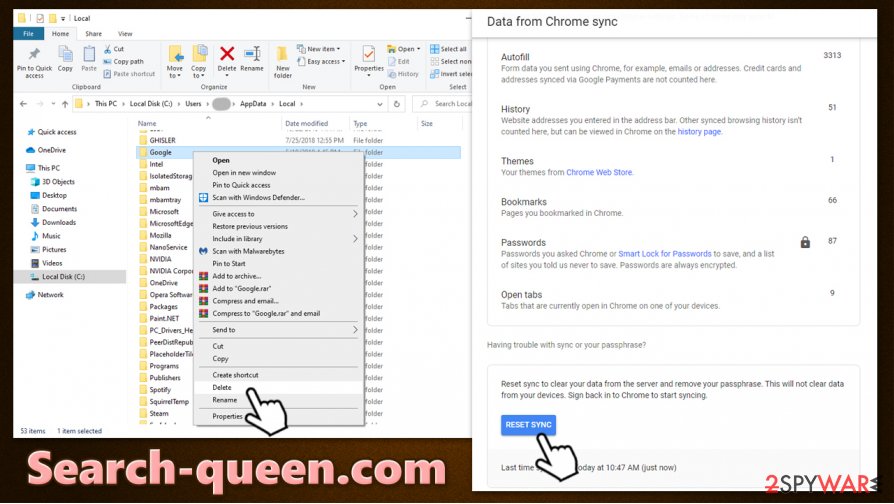Search-queen.com (Free Guide) - Chrome, Firefox, IE, Edge
Search-queen.com Removal Guide
What is Search-queen.com?
Search-queen.com is a redirect virus that hijacks all the installed web browsers

If your searchers are being redirected to Search-queen.com web address on Google Chrome, Mozilla Firefox, Safari, MS Edge, or another web browser, it is highly likely that you have an adware program installed on your computer. Adware, otherwise known as ad-supported software, is usually installed unintentionally due to deceptive distribution methods, although some apps, such as browser extensions, can go rogue as well.
As a result, users might spot Search Queen redirects seemingly out of nowhere. As soon as they type in the search query, their URL bar would briefly show the Search-queen.com domain, followed by a redirect to Bing, Yahoo, or another search provider. This phenomenon is typical to adware, and, in order to eliminate the hijack, users need to find and delete the program that is causing this behavior.
| Name | Search-queen.com, Search Queen |
|---|---|
| Type | Adware, potentially unwanted program |
| Distribution | Software bundles, third-party websites, deceptive ads, fake Flash Player update prompts |
| Symptoms | Unknown browser extension or application installed; intrusive deals, coupons, discounts, offers, and other advertisements; redirects to Bing, Yahoo, or other search engines; redirects to Search-queen.com; |
| Consequences | Misleading search results might disturb normal web browsing sessions. Redirects to third-party sites might sometimes lead to scam, phishing, or malware-laden sites |
| Elimination | To get rid of unwanted apps manually, you can follow our removal guide below. If the unwanted ads and other disruptive behavior does not stop, you should scan your computer with security software and delete all threats automatically |
| Further steps | Malware or adware infections can diminish the performance of your computer or cause serious stability issues. Use FortectIntego to remediate your device and ensure that the virus damage is fixed |
It is yet unknown what type of application is related to the Search-queen.com hijack. In most cases, suspicious applications manage to slip into users' machines during the installation of freeware from third-party websites (hence, users notice browser changes seemingly out of nowhere). Nonetheless, it is also important to note that the unwanted apps often come as browser extensions, some of which might have been operating well for months or years and only later going rogue.
The so-called Search Queen virus is not actually malicious, although it can be extremely annoying. Constant redirects to a search provider you are not used to or straight out hate is not a nice experience. It also does not help that search results are filled with sponsored links and ads. It is also important to note that Bing or Yahoo redirects are not directly related to these tech companies, but rather to a potentially unwanted program installed on your system.
Users reported that Search-queen.com removal was unsuccessful after trying to eliminate it with anti-malware software. Therefore, we would like to suggest alternative solutions that might just work – SpyHunter 5Combo Cleaner or Malwarebytes and find the most potentially unwanted programs on the system and terminate them in just a few minutes. Additionally, you can check our instructions below on how to find and delete unwanted applications from Windows and Mac computers. Note that if security software found invisible threats such as Trojans, worms, or other malware, you should also perform additional checks with FortectIntego repair software.

Unfortunately, in some cases, even a scan with security software will not help you remove Search-queen.com virus from the system. This is because browsers can be hijacked without any app being installed on your system. Therefore, in order to delete Search Queen from your web browser, you will have to check and clean it promptly. For more information on how to do it, please check the bottom section of the article.
Unexpected browser hijack explained
By its definition, adware is not malicious, although some security researchers highly disagree. Some adware can significantly lower computer defenses and result in infection of malicious programs. In addition, it can also result in less than a pleasant web browsing experience due to an increased number of ads, changed search provider, and redirects.
As previously mentioned, most adware is installed along with other programs downloaded from the internet. This happens when software developers do not adequately disclose optional components inserted into a single installer deliberately. Therefore, experts advise following these steps if you want to avoid potentially unwanted programs in the future:
- If possible, download apps from official sources only;
- When dealing with third-party freeware, keep in mind that you might be offered system optimizers, browser extensions, video players, file converters, or other software;
- Always pick Advanced/Custom mode if such is available during the installation process;
- Decline all the offers when suggested;
- Remove the ticks from checkboxes that would otherwise allow the installation of optional apps;
- Install a powerful security application that could protect you from potentially unwanted programs and other computer nasties.
Can't remove Search-queen.com from your browser? Follow these steps
As the first step for Search-queen.com removal, we highly recommend checking the apps on your machine – make sure that you know what is installed (if you don't know how to do that, please check the guide below). It is highly unlikely you will find the “Search Queen” app installed, however, as adware redirects are rarely associated with the related program names.
If you could not find a suspicious application, you should attempt to remove Search-queen.com virus by checking your web browser. There are several components that you should clean, which include:
- Delete all browser extensions
- Clear cookies and browser data
- Reset Chrome Sync
- Delete Google folder inside the AppData in the following location: C:\Users\[username]\AppData\Local

Finally, you should also fully scan with your computer with powerful anti-malware software, such as SpyHunter 5Combo Cleaner or Malwarebytes, and then perform further checks with FortectIntego repair software. If none of the steps listed above helped eliminate the virus, you should reset the web browser or reinstall it all together.
You may remove virus damage with a help of FortectIntego. SpyHunter 5Combo Cleaner and Malwarebytes are recommended to detect potentially unwanted programs and viruses with all their files and registry entries that are related to them.
Getting rid of Search-queen.com. Follow these steps
Uninstall from Windows
To delete unwanted programs from Windows systems, follow these steps:
Instructions for Windows 10/8 machines:
- Enter Control Panel into Windows search box and hit Enter or click on the search result.
- Under Programs, select Uninstall a program.

- From the list, find the entry of the suspicious program.
- Right-click on the application and select Uninstall.
- If User Account Control shows up, click Yes.
- Wait till uninstallation process is complete and click OK.

If you are Windows 7/XP user, proceed with the following instructions:
- Click on Windows Start > Control Panel located on the right pane (if you are Windows XP user, click on Add/Remove Programs).
- In Control Panel, select Programs > Uninstall a program.

- Pick the unwanted application by clicking on it once.
- At the top, click Uninstall/Change.
- In the confirmation prompt, pick Yes.
- Click OK once the removal process is finished.
Delete from macOS
If you are using macOS and seeing unexpected redirects, follow these instructions to get rid of unwanted apps:
Remove items from Applications folder:
- From the menu bar, select Go > Applications.
- In the Applications folder, look for all related entries.
- Click on the app and drag it to Trash (or right-click and pick Move to Trash)

To fully remove an unwanted app, you need to access Application Support, LaunchAgents, and LaunchDaemons folders and delete relevant files:
- Select Go > Go to Folder.
- Enter /Library/Application Support and click Go or press Enter.
- In the Application Support folder, look for any dubious entries and then delete them.
- Now enter /Library/LaunchAgents and /Library/LaunchDaemons folders the same way and terminate all the related .plist files.

Remove from Microsoft Edge
Delete unwanted extensions from MS Edge:
- Select Menu (three horizontal dots at the top-right of the browser window) and pick Extensions.
- From the list, pick the extension and click on the Gear icon.
- Click on Uninstall at the bottom.

Clear cookies and other browser data:
- Click on the Menu (three horizontal dots at the top-right of the browser window) and select Privacy & security.
- Under Clear browsing data, pick Choose what to clear.
- Select everything (apart from passwords, although you might want to include Media licenses as well, if applicable) and click on Clear.

Restore new tab and homepage settings:
- Click the menu icon and choose Settings.
- Then find On startup section.
- Click Disable if you found any suspicious domain.
Reset MS Edge if the above steps did not work:
- Press on Ctrl + Shift + Esc to open Task Manager.
- Click on More details arrow at the bottom of the window.
- Select Details tab.
- Now scroll down and locate every entry with Microsoft Edge name in it. Right-click on each of them and select End Task to stop MS Edge from running.

If this solution failed to help you, you need to use an advanced Edge reset method. Note that you need to backup your data before proceeding.
- Find the following folder on your computer: C:\\Users\\%username%\\AppData\\Local\\Packages\\Microsoft.MicrosoftEdge_8wekyb3d8bbwe.
- Press Ctrl + A on your keyboard to select all folders.
- Right-click on them and pick Delete

- Now right-click on the Start button and pick Windows PowerShell (Admin).
- When the new window opens, copy and paste the following command, and then press Enter:
Get-AppXPackage -AllUsers -Name Microsoft.MicrosoftEdge | Foreach {Add-AppxPackage -DisableDevelopmentMode -Register “$($_.InstallLocation)\\AppXManifest.xml” -Verbose

Instructions for Chromium-based Edge
Delete extensions from MS Edge (Chromium):
- Open Edge and click select Settings > Extensions.
- Delete unwanted extensions by clicking Remove.

Clear cache and site data:
- Click on Menu and go to Settings.
- Select Privacy, search and services.
- Under Clear browsing data, pick Choose what to clear.
- Under Time range, pick All time.
- Select Clear now.

Reset Chromium-based MS Edge:
- Click on Menu and select Settings.
- On the left side, pick Reset settings.
- Select Restore settings to their default values.
- Confirm with Reset.

Remove from Mozilla Firefox (FF)
Remove dangerous extensions:
- Open Mozilla Firefox browser and click on the Menu (three horizontal lines at the top-right of the window).
- Select Add-ons.
- In here, select unwanted plugin and click Remove.

Reset the homepage:
- Click three horizontal lines at the top right corner to open the menu.
- Choose Options.
- Under Home options, enter your preferred site that will open every time you newly open the Mozilla Firefox.
Clear cookies and site data:
- Click Menu and pick Settings.
- Go to Privacy & Security section.
- Scroll down to locate Cookies and Site Data.
- Click on Clear Data…
- Select Cookies and Site Data, as well as Cached Web Content and press Clear.

Reset Mozilla Firefox
If clearing the browser as explained above did not help, reset Mozilla Firefox:
- Open Mozilla Firefox browser and click the Menu.
- Go to Help and then choose Troubleshooting Information.

- Under Give Firefox a tune up section, click on Refresh Firefox…
- Once the pop-up shows up, confirm the action by pressing on Refresh Firefox.

Remove from Google Chrome
You should clean your web browser when trying to remove Search Queen redirects. If that does not help, reset it:
Delete malicious extensions from Google Chrome:
- Open Google Chrome, click on the Menu (three vertical dots at the top-right corner) and select More tools > Extensions.
- In the newly opened window, you will see all the installed extensions. Uninstall all the suspicious plugins that might be related to the unwanted program by clicking Remove.

Clear cache and web data from Chrome:
- Click on Menu and pick Settings.
- Under Privacy and security, select Clear browsing data.
- Select Browsing history, Cookies and other site data, as well as Cached images and files.
- Click Clear data.

Change your homepage:
- Click menu and choose Settings.
- Look for a suspicious site in the On startup section.
- Click on Open a specific or set of pages and click on three dots to find the Remove option.
Reset Google Chrome:
If the previous methods did not help you, reset Google Chrome to eliminate all the unwanted components:
- Click on Menu and select Settings.
- In the Settings, scroll down and click Advanced.
- Scroll down and locate Reset and clean up section.
- Now click Restore settings to their original defaults.
- Confirm with Reset settings.

Delete from Safari
Remove unwanted extensions from Safari:
- Click Safari > Preferences…
- In the new window, pick Extensions.
- Select the unwanted extension and select Uninstall.

Clear cookies and other website data from Safari:
- Click Safari > Clear History…
- From the drop-down menu under Clear, pick all history.
- Confirm with Clear History.

Reset Safari if the above-mentioned steps did not help you:
- Click Safari > Preferences…
- Go to Advanced tab.
- Tick the Show Develop menu in menu bar.
- From the menu bar, click Develop, and then select Empty Caches.

After uninstalling this potentially unwanted program (PUP) and fixing each of your web browsers, we recommend you to scan your PC system with a reputable anti-spyware. This will help you to get rid of Search-queen.com registry traces and will also identify related parasites or possible malware infections on your computer. For that you can use our top-rated malware remover: FortectIntego, SpyHunter 5Combo Cleaner or Malwarebytes.
How to prevent from getting adware
Access your website securely from any location
When you work on the domain, site, blog, or different project that requires constant management, content creation, or coding, you may need to connect to the server and content management service more often. The best solution for creating a tighter network could be a dedicated/fixed IP address.
If you make your IP address static and set to your device, you can connect to the CMS from any location and do not create any additional issues for the server or network manager that needs to monitor connections and activities. VPN software providers like Private Internet Access can help you with such settings and offer the option to control the online reputation and manage projects easily from any part of the world.
Recover files after data-affecting malware attacks
While much of the data can be accidentally deleted due to various reasons, malware is one of the main culprits that can cause loss of pictures, documents, videos, and other important files. More serious malware infections lead to significant data loss when your documents, system files, and images get encrypted. In particular, ransomware is is a type of malware that focuses on such functions, so your files become useless without an ability to access them.
Even though there is little to no possibility to recover after file-locking threats, some applications have features for data recovery in the system. In some cases, Data Recovery Pro can also help to recover at least some portion of your data after data-locking virus infection or general cyber infection.























